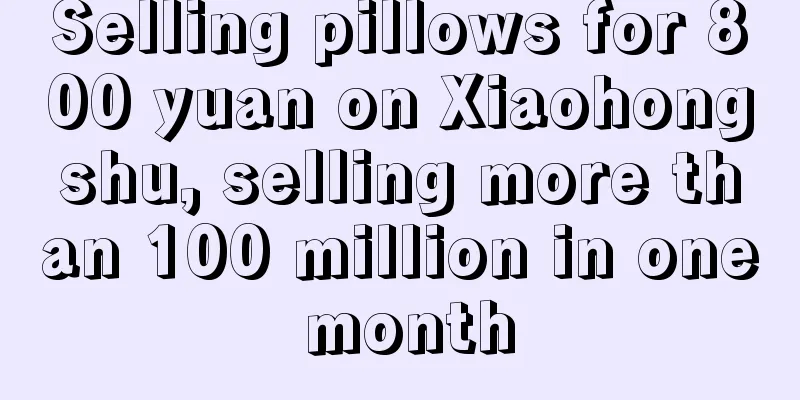Who is bearing the cost of e-commerce price wars?

Douyin E-commerce is determined to make a comeback in transaction volume in 2024, and has set "pricing power" as its top priority this year, which shows how determined it is. According to people familiar with the matter, Douyin's e-commerce low-price strategy will be fully implemented. Not only will low-priced goods be vigorously promoted in shopping malls and short videos, but the live broadcast room will continue to be a display stage for brands' high-priced goods. Last year, Douyin's e-commerce transaction volume reached 2.2 trillion yuan, which is a good result, but still far behind Pinduoduo's 4 trillion yuan. In 2024, if Douyin's e-commerce wants to achieve the goal of 3 trillion yuan, the transaction volume needs to increase by more than 36%, which is almost several times the growth rate of the entire e-commerce market. 1. “Once” e-commerce simply offered low pricesIn the past e-commerce world, JD.com, Taobao, and Pinduoduo used low-price strategies to attract consumers. They achieved low prices through methods such as "putting pressure on factories, optimizing supply chains, improving efficiency, and economies of scale." Liu Qiangdong once emphasized: "Ensuring low prices based on quality and service was the most important weapon for success in the past, and it is also the only basic weapon in the future." JD's low-price strategy is achieved by optimizing the supply chain and improving efficiency. The Wujie M5 desktop computer launched by JD.com in cooperation with Mechanical Revolution is a typical example. This desktop computer costs less than 2,000 yuan, but its performance is excellent. The reason why JD.com was able to keep the price so low is that they had an early insight into consumers' demand for such products, and through the advantages of supply chain resources, they reached a large-scale procurement agreement with upstream component manufacturers, reducing procurement costs. JD.com has been deeply involved in the supply chain, providing brands with full life cycle support from R&D, design, research, marketing to services. The hardware products launched by Zuoyebang are a beneficiary. Based on the exploration of user needs, JD.com assists Zuoyebang in making product positioning decisions, making it more in line with market demand in terms of screen size, memory capacity, content bias, etc. JD.com has also done an excellent job in terms of inventory. They have gathered a large amount of consumer demand, predicted supply and demand changes through technical capabilities, and achieved refined inventory management and stable cash flow. Taobao, another giant in the e-commerce industry, also knows how to keep prices low. They reduce costs by going deep into factories in industrial belts and reducing the circulation links of merchants. Baigou, Hebei is a typical example. This small town is one of the largest luggage production and sales bases in the country. Taobao has set its sights on this industrial belt to help merchants reduce inventory and improve circulation efficiency. By participating in Taobao's promotional activities, Baigou's luggage merchants not only increased sales and user stickiness, but also reduced inventory costs. For some big brands, they have a complete pricing system and market positioning. Therefore, e-commerce platforms such as Taobao attract consumers by launching more cost-effective products. For example, adding gifts such as samples or replacement cores while keeping the price unchanged not only improves the cost-effectiveness of the products, but also meets the diverse needs of consumers. Pinduoduo uses the "group buying model" to implement its low-price strategy. They take full advantage of consumers' desire for cost-effectiveness and organize a large number of group buying activities. When enough people gather to buy the same product, merchants can give bigger discounts. This model not only reduces the price of goods, but also increases consumers' desire to buy and stickiness. With its huge user base and growing influence, Pinduoduo is able to work directly with manufacturers and eliminate intermediaries to reduce costs. In addition to the group purchase model, Pinduoduo also focuses on cooperation with the rural market. They cooperate with farmers' cooperatives and agricultural product distribution companies to sell high-quality agricultural products directly on the platform. In addition, Pinduoduo has also opened up a factory direct supply model through cooperation with manufacturers. In this model, manufacturers directly put their products on Pinduoduo for sale. Traditional e-commerce giants such as JD.com, Taobao, and Pinduoduo "have gradually discovered" that they need to "regain" the balance between price, quality, and service. 2. The low-price war: the choices of giants and the game between small and medium-sized businessesAt the beginning of 2024, e-commerce giants such as Douyin, Pinduoduo, and JD.com have all raised the "low price banner". Low prices contain both shackles and opportunities. Let's look at the "opportunities" first. Douyin e-commerce has vigorously introduced white-label and small and medium-sized merchants, trying to attract more consumers through low-price strategies. However, the implementation of this strategy has had a significant impact on Douyin's advertising revenue. After all, small and medium-sized brands and merchants have low gross profit margins and limited budgets for marketing. This has led to the embarrassing situation of Douyin e-commerce having to face declining advertising revenue while promoting low-price strategies. However, Douyin e-commerce did not give up its low-price strategy. Instead, it chose a more "aggressive" strategy: extending the low-price strategy to the content field, including shopping malls, short videos and live broadcast rooms. Unlike Douyin's aggressive e-commerce strategy, Pinduoduo has chosen a more stable low-price strategy. Pinduoduo's success is largely attributed to its e-commerce model of "surrounding the city from the countryside" and dimensionality reduction. Against the backdrop of consumption upgrades, Pinduoduo has gone the other way and met the consumption needs of the grassroots masses through the group buying model of social e-commerce and viral communication. Pinduoduo's low-price strategy was not achieved overnight. At the beginning of its launch, Pinduoduo quickly accumulated a large number of users by encouraging users to call their friends to "get the best deals" and "cut the prices". Although these users have limited spending power, their large number has laid a solid foundation for Pinduoduo's rapid development. Unlike Douyin and Pinduoduo, JD.com has chosen to implement a low-price strategy by continuously stimulating the release of economies of scale. On the one hand, JD.com has increased the volume and efficiency of its supply chain and reduced procurement costs; on the other hand, it has increased its overall transaction volume through the economies of scale of its self-operated business and by stabilizing the rapid growth of its third-party merchant segment. JD.com's low-price strategy is not simply a price reduction promotion, but rather it achieves overall price advantage by asking the supply chain for low prices and optimizing the cost structure. However, while e-commerce giants are offering low prices, some are choosing a more difficult path. The news that Dongfang Zhenxuan is trying out the “hourly delivery” business has given people a glimpse of new possibilities in the e-commerce industry. Although Dongfang Zhenxuan’s “hourly delivery” business does not currently have scale advantages, its courage to try new models is worthy of recognition. In any case, the e-commerce low-price war in 2024 has already begun. 3. The real chess game behind the price war: a life-and-death game between small and medium-sized businesses and factoriesAs for the various platforms that have suddenly realized the shackles of "only low prices" and started to seek a new ecosystem of "price power", in fact, when consumers are immersed in the "lowest price" carnival, few people pay attention to the real payers of this war - small and medium-sized businesses and factories. Quest Mobile data shows that since March this year, Taobao's daily active users have increased for five consecutive months, making it the only e-commerce platform with a DAU of over 400 million. Behind this number are countless small and medium-sized businesses struggling in the price war. In order to compete for limited traffic, they have to lower prices again and again, and even sell goods at prices below cost. "We used to be able to live on profits, but now we can only fight for sales." A seller of stationery said helplessly. He recalled the moment when the platform's waiter's attitude changed, as if he saw the true face of this price war. The links thrown by the other party were all from Douyin and Pinduoduo's low-priced hot products. In such an environment, small and medium-sized businesses have to do their best to adapt to this war. They must not only pay attention to market price changes, but also adjust their supply chain and cost structure at any time. Some businesses even began to try to move production lines to lower-cost areas to reduce costs. However, such an approach is undoubtedly a poison to quench thirst. "Our profit margin has now dropped to less than 1%." Da A said with a wry smile. He did the math and realized that if they continued to fight a price war, they would soon face losses. However, if they did not participate in this war, they would lose valuable traffic and market share. This "price war" also has a profound impact on factories. In order to cater to the needs of merchants, some factories have to abandon their original brand recognition and quality standards and turn to producing low-priced, low-quality goods. This practice not only damages the long-term development of the factory, but also damages the ecological environment of the entire industry. However, this war is not without winners. The platforms have gained huge traffic and market share in this war, but they have also paid a heavy price. They have to face complaints and boycotts from merchants and factories, as well as consumers' disappointment and dissatisfaction with low-priced and low-quality goods. In the long run, "pure price war" is not a sustainable path for the development of e-commerce. Platforms need to find a healthier and more balanced way of development so that merchants, factories and consumers can all obtain reasonable benefits. Only in this way can the e-commerce industry truly achieve healthy and sustainable development. Otherwise, the "price war" that once seemed fierce will ultimately make everyone a loser. The pleasure of "explosive orders" is like a passing cloud, which is difficult to dispel the anxiety of continued growth. Today, Douyin has entered the shelf e-commerce, trying to find new growth points in the hinterland of traditional e-commerce. However, without the advantages of content and interest, it seems powerless in the competition of commodity quantity, brand, logistics and price. Looking back at the long history of e-commerce, former price war giants such as Gome and Suning have faded into obscurity, which is a profound reflection on the pure price competition strategy. Price wars may seem simple and crude, but they actually hurt others and yourself. It requires platforms to either continue to provide heavy subsidies or squeeze the profits of brands and factories, but this path will not go far. When JD.com launched the 10 billion subsidy channel again, the market seemed to smell the price war. However, more than a month later, the imagined smoke of war did not spread. While emphasizing "low prices", major platforms deliberately avoided mentioning the three words "price war". Alibaba Chairman and CEO Zhang Yong’s remarks in the earnings call hit the nail on the head: No company can change the situation through continued price subsidies; innovation in technology and business mechanisms is the right way to go. At the same time, the concept of "price power" gradually emerged. For users, the price is attractive; for platforms and merchants, the same product has the ability to be offered at a "good price". This is not only the new direction proposed by Alibaba, but also the goal pursued by e-commerce platforms such as JD.com. Good products, good prices, and global direct access, this kind of shopping experience is what consumers really need. The era of traffic supremacy has passed, and consumer attention has become both expensive and cheap. Price wars and public relations wars between platforms and manufacturers can no longer attract consumers' long-term attention. The key issue is whether we can receive and retain traffic. In this ecosystem, price is an important factor but not the only one. If the platform pursues low prices, it will inevitably lead to bad money driving out good money and the entire manufacturing industry losing the motivation to ensure profits and innovate quality. How to ensure that all participants on the platform - the platform, merchants, supply chain, consumers, and shareholders - can survive healthily and happily is an eternal topic for e-commerce platforms. In the past few years, the ecological construction of various platforms has been more or less biased. Although Taobao and Tmall have won the market with rich categories and long-tail effects, their bidding ranking rules have also been criticized; the brand value of JD.com's self-operated and logistics services makes consumers feel at ease, but the prices are also relatively high; Pinduoduo's low-price strategy has led to uneven product quality, affecting user experience and the entry of high-value brands. Nowadays, major e-commerce platforms have begun to correct themselves, upholding the "low price and high quality" strategy and highlighting the "price power" rule to activate daily consumption of platform users. The "long-termism" that Dai Shan repeatedly mentioned at the closed-door meeting is a profound reflection on the future development of e-commerce platforms. Obviously, this round of "low-price" changes in e-commerce is not a simple "price war", but a self-adjustment and upgrade carried out by major platforms after careful consideration. The goal is clear, to create a platform ecosystem with both "good products" and "good prices" so that consumers can enjoy the fun of shopping while also obtaining tangible benefits. Author: Li Mumu, Editor: Hu Zhanjia, Operation: Chen Jiahui Source public account: LingTai LT (ID: LingTai_LT), sharp, objective and unique business insights. |
<<: The 146th day of Hema’s “turning over the table”
Recommend
Can shein be logged in in China?
For Chinese consumers, they may be curious whether...
[Planting flowers in private domains and planting grass in public domains] Full-link content marketing methods for small and beautiful businesses
The core of a small and beautiful business is to a...
What are the dedicated lines for cross-border e-commerce logistics? What are the logistics models?
With the rapid development of cross-border e-comme...
Chinese companies win the World Cup marketing war
The 2022 World Cup is over, Argentina won the cham...
Low frequency + high customer orders, member repurchase rate exceeds 32%. How does Chow Tai Fook manage its membership operations?
In the era of inventory, companies are trying ever...
More convenient! Taobao will fully support WeChat payment!
For a long time, due to commercial competition and...
Help! How to write the recommendations section of a data analysis report?
When writing a data analysis report, how to conver...
ChatGPT continues to be popular, where should AI marketing go?
The AI era has quietly arrived, and the term &qu...
"Zibo Ding Zhen" duck head brother breaks into the world of live streaming
When his 15 minutes of fame came to him, the young...
8 details of a good content!
How to write a hit article with more than 100,000 ...
Is it necessary to bind a legal person to Amazon payment? What are the payment accounts?
Amazon merchants should all know that Amazon's...
How to grow private domain activities like a "big company"
To achieve growth, you need not only a global pers...
How to watch Shopee live broadcast? How to activate Shopee live broadcast?
Many people buy overseas imported goods on the Sho...
How to top up Lazada wallet? How to withdraw cash from Lazada wallet?
With the rapid development of e-commerce, online p...
How to “take advantage of crisis and turn crisis into opportunity” in crisis public relations from the BMW MINI incident
The BMW MINI incident was a hot topic. As a market...









